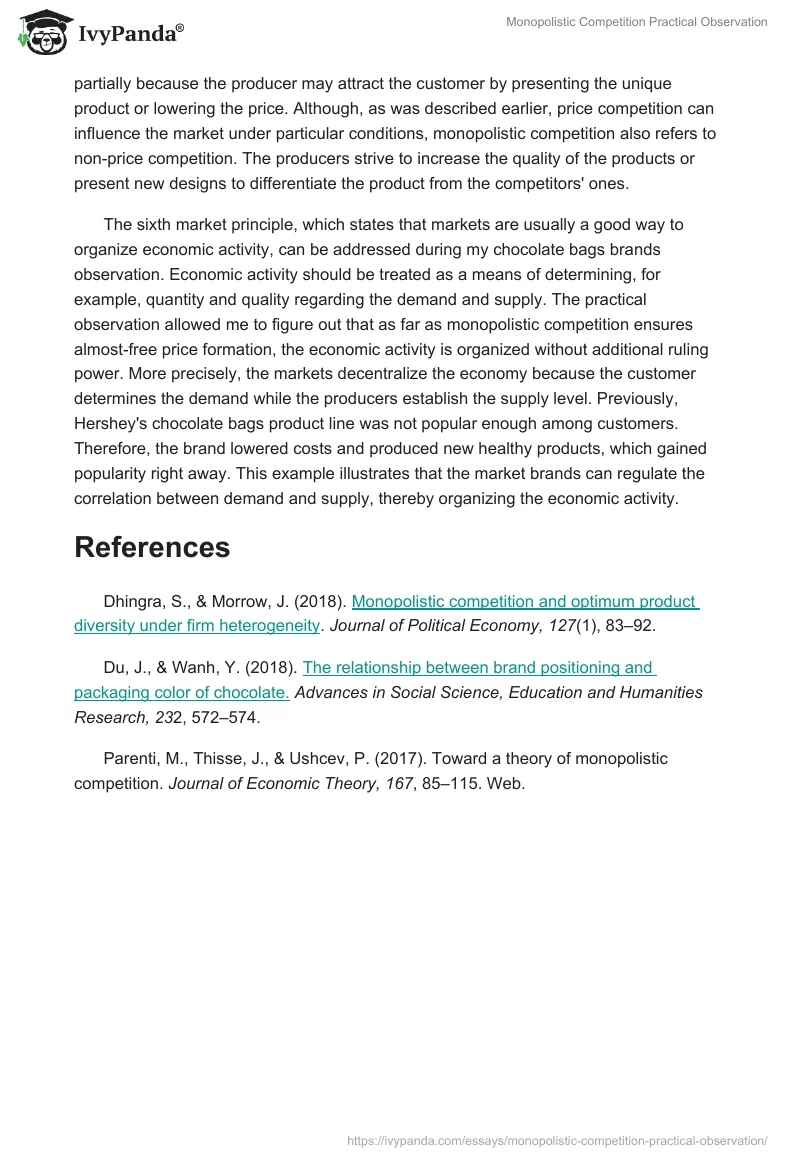For the monopolistic competition practical observation, two brands of chocolate production were chosen: Dove and Hershey. Specifically, the dark chocolate candy bags of two brands were analyzed. The prices for the Dove chocolate bags were approximately 10 dollars higher than the Hershey ones. Regarding the design, Dove used the traditional for the company logo and color pallet with the additional images of the colorful-packaged chocolates included in the bag. Hershey’s production had more gloom combinations of brown, green, and red colors (Du and Wang, 2018). The peculiar design feature of the bags was the standing out sign of organic production. The Dove chocolate bags, as well as the Hershey’s production, were placed on the middle shop shelves where people could quickly notice the product. The essential criterion was that the goods differed in ingredients (Dhingra and Morrow, 2019). The price changing was conditioned by the uniqueness of the product and its quality. Hershey’s production was likely to be oriented toward the price-conscious consumer because it had a wide variety of price categories.
The repeated observation allowed me to figure out that the mentioned example is a monopolistic competition because the brand companies can change the prices, adding specific features to the products. Hershey’s chocolate bags without organic components had lower costs than Dove’s ones. The non-price competition was the marketing strategy used by brands because they strived primarily to improve the quality of their products rather than to upper the cost (Parenti et al., 2017). The differentiated products were unique but, at the same time, had similar features, which defined the chocolate market as having monopolistic competition.
During the observation, I could have applied my theoretical knowledge in practice to analyze the products. I found out that monopolistic competition is a widespread phenomenon because many goods were suitable for my observation. I have also learned that when a new similar product is released, many brands lower the costs slightly unless they have a new unique product. Therefore, the prices change in monopolistic competition has its limits. In conditions of monopolistic competition, the main differentiating feature of the goods is cost. Each firm can control the price only partially because the producer may attract the customer by presenting the unique product or lowering the price. Although, as was described earlier, price competition can influence the market under particular conditions, monopolistic competition also refers to non-price competition. The producers strive to increase the quality of the products or present new designs to differentiate the product from the competitors’ ones.
The sixth market principle, which states that markets are usually a good way to organize economic activity, can be addressed during my chocolate bags brands observation. Economic activity should be treated as a means of determining, for example, quantity and quality regarding the demand and supply. The practical observation allowed me to figure out that as far as monopolistic competition ensures almost-free price formation, the economic activity is organized without additional ruling power. More precisely, the markets decentralize the economy because the customer determines the demand while the producers establish the supply level. Previously, Hershey’s chocolate bags product line was not popular enough among customers. Therefore, the brand lowered costs and produced new healthy products, which gained popularity right away. This example illustrates that the market brands can regulate the correlation between demand and supply, thereby organizing the economic activity.
References
Dhingra, S., & Morrow, J. (2018). Monopolistic competition and optimum product diversity under firm heterogeneity. Journal of Political Economy, 127(1), 83–92.
Du, J., & Wanh, Y. (2018). The relationship between brand positioning and packaging color of chocolate.Advances in Social Science, Education and Humanities Research, 232, 572–574.
Parenti, M., Thisse, J., & Ushcev, P. (2017). Toward a theory of monopolistic competition. Journal of Economic Theory, 167, 85–115. Web.


